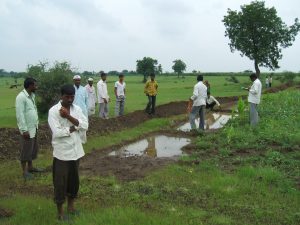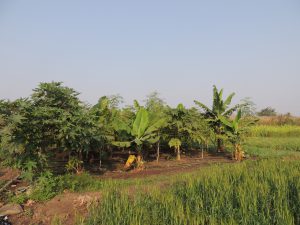Climate resilient agriculture is an essential component of food security in India, a country that relies heavily on agriculture for its economic growth and livelihoods. India’s diverse agro-climatic zones, coupled with its monsoon-based agriculture, make the country highly vulnerable to the impacts of climate change, including extreme weather events such as floods, droughts, and heatwaves. Climate change is expected to exacerbate these challenges, leading to lower agricultural productivity and food insecurity. In this post, we will discuss why climate resilient agriculture is critical for food security in India, and how it can be achieved through science-based solutions.
What is Food Security?
According to the Food and Agriculture Organization (FAO) of the United Nations, food security is defined as “a situation that exists when all people, at all times, have physical, social, and economic access to sufficient, safe, and nutritious food that meets their dietary needs and food preferences for an active and healthy life.” This definition highlights the importance of not only access to food, but also its safety and nutritional adequacy, as well as the economic and social conditions that enable people to obtain and utilize it.
A food-secure community or region is one that has access to a sustainable supply of food at all times, with the ability to acquire it through purchase, production, or other means. Food security is a crucial aspect of human development, as inadequate access to food can lead to malnutrition, hunger, and other health problems.
Where does India stand on Food Security?
India has made significant progress in improving food security over the past few decades, but challenges remain. According to the Global Hunger Index 2022, India’s score improved from 38.9 in 2000 to 29.1 in 2022, indicating a reduction in hunger and undernutrition. However, India still ranks 107 out of 121 countries on the index, indicating that there is much room for improvement.
India’s National Food Security Act (NFSA) of 2013, also known as the Right to Food Act is one of the world’s largest food security programs, aiming to provide subsidized food grains to over 800 million people in the country. The program has helped to improve access to food for millions of people, but challenges such as leakages and inefficiencies in the distribution system still need to be addressed.
Climate change, natural disasters, and the COVID-19 pandemic have also posed significant challenges to India’s food security. In recent years, the country has experienced several extreme weather events, including droughts and floods, that have impacted crop yields and food production. The pandemic has disrupted supply chains and led to economic hardships for many households, making it difficult for them to access food.
Overall, India has made progress in improving food security, but there is still a need for continued efforts to address the remaining challenges and ensure that all people have access to safe, nutritious, and affordable food.
The Importance of Agriculture for Food Security in India
With a population of over 1.4 billion people, India is one of the world’s largest food producers and consumers. Agriculture is the primary source of food production in India. The country’s farmers grow a wide range of crops, including rice, wheat, pulses, vegetables, fruits, and oilseeds, which contribute significantly to the country’s food supply.
Agriculture plays a crucial role in India’s economy, accounting for 20% of the country’s GDP and providing livelihoods to over 50% of its population. Agriculture also helps to stabilize food prices in the country by ensuring a steady supply of food to the market. This helps to prevent food shortages and price spikes, which can be particularly devastating for low-income households. Given this crucial role that Agriculture plays in ensuring Food security of the country, it becomes vital to ensure its sustainability. However, climate change threatens to disrupt agricultural productivity and food security in the country, with significant implications for human health and well-being.
Climate Change Impacts on Agriculture in India
India has experienced several climate-related disasters in recent years, including heatwaves, droughts, floods, and landslides. These extreme weather events have led to significant crop losses and reduced yields, posing a threat to food security. Climate change is expected to exacerbate these impacts, with studies projecting a decline in agricultural productivity in many regions of the country. For instance, the frequency and intensity of droughts are projected to increase in many parts of India, leading to reduced soil moisture and crop failures.
Similarly, changes in temperature and rainfall patterns are expected to alter the distribution of pests and diseases, affecting crop health and productivity. According to a report by the Indian Council of Agricultural Research (ICAR), climate change is projected to adversely affect crop yields in India, leading to a decline in food production by 6-10% by 2050. The report also highlights that the impacts of climate change are expected to be more pronounced in vulnerable regions like the Indo-Gangetic plains, eastern and northeastern India, and the Western Ghats.
According to another report by the Ministry of Environment, Forest and Climate Change, India’s food security is at risk due to changes in rainfall patterns, which will affect crop productivity, and an increase in the frequency and intensity of extreme weather events like droughts and floods.
Climate Resilient Agriculture for Indian Farmers
Climate-resilient agriculture is the way forward to cope with these challenges. The Intergovernmental Panel on Climate Change (IPCC) defines climate-resilient agriculture as “the management of agricultural systems to be resilient to climate change, including variability and extremes, in order to maintain and increase agricultural productivity and income, and to reduce greenhouse gas emissions.” The IPCC emphasizes the need for a “multifunctional approach” to climate-resilient agriculture that takes into account environmental, social, and economic factors.
Climate Resilient Agriculture involves sustainable agricultural practices that enhance productivity, mitigate risks, and reduce greenhouse gas emissions. By adopting climate-resilient agriculture, farmers can ensure food security in the face of extreme weather events and climate change.
The Indian government has launched several initiatives to promote climate-resilient agriculture, including the flagship programme, National Initiative on Climate Resilient Agriculture (NICRA). The National Mission for Sustainable Agriculture (NMSA) is another such initiative that aims to promote sustainable agriculture practices to enhance productivity, soil health, and water use efficiency. The mission also aims to build resilience to climate change by promoting climate-resilient agriculture practices.
The Pradhan Mantri Fasal Bima Yojana (PMFBY) is another government initiative that provides crop insurance to farmers against losses due to natural calamities. The scheme aims to support farmers in adopting climate-resilient agriculture practices by reducing their financial risks and encouraging them to invest in sustainable agriculture practices.
Several organizations in India, including WOTR are promoting and implementing CRA practices to build more resilient and sustainable agricultural systems. Some of these practices are classified as follows:
Agroforestry:
Agroforestry involves the cultivation of trees along with crops, which can help to improve soil health, reduce soil erosion, and enhance biodiversity. It also provides multiple benefits such as wood, fodder, and fruit, which can improve farmers’ income and livelihoods.
WOTR promotes agroforestry across relevant locations where farmers are growing trees such as neem, moringa, and custard apple, along with crops such as paddy, maize, and vegetables. This practice has helped to increase soil moisture retention, reduce soil erosion, and provide multiple benefits to farmers.
Soil and Water Conservation:
Soil and water conservation techniques such as contour bunding, farm ponds, and check dams can help to improve soil moisture retention, reduce soil erosion, and increase groundwater recharge. These practices can also help farmers to cope with droughts and water scarcity, which are becoming more frequent due to climate change.
WOTR has been promoting several soil and water conservation techniques such as contour trenching, gully plugging, and percolation tanks across its locations in 8 states. These practices have helped to increase soil moisture retention, reduce soil erosion, and provide water for irrigation and domestic use.
Sustainable Agriculture:
WOTR promotes sustainable agriculture practices such as crop diversification, organic farming, and integrated pest management to reduce the use of chemical inputs and improve soil health. These practices also reduce greenhouse gas emissions and improve farmers’ income and food security.
Climate Information Services:
WOTR has developed a climate information service (CIS) to provide farmers with weather forecasts, agro-advisories, and other climate-related information. This helps farmers to make informed decisions about their farming practices and manage climate risks more effectively.
 FarmPrecise, a mobile application developed by WOTR generates dynamic weather-based crop management advisories that are tailored to crop and farm specific conditions and is in use by over 70000 farmers across 4 states and is available in 5 languages.
FarmPrecise, a mobile application developed by WOTR generates dynamic weather-based crop management advisories that are tailored to crop and farm specific conditions and is in use by over 70000 farmers across 4 states and is available in 5 languages.
Livestock Management:
Livestock management practices such as stall-feeding and mixed cropping can improve the productivity and resilience of livestock systems. These practices also reduce the pressure on natural resources such as grazing lands, which are becoming scarce due to climate change.

WOTR has been promoting livestock management practices, such as stall-feeding of goats and mixed cropping of legumes and cereals. These practices have helped to improve the productivity and resilience of livestock systems and reduce the pressure on grazing lands.
In Conclusion
Overall, there is a need to build more resilient and sustainable agricultural systems. However, there are also several challenges to promoting and implementing CRA practices, such as lack of awareness and capacity among farmers, lack of access to finance and markets, and policy and institutional barriers. To overcome these challenges, it is important to strengthen partnerships between farmers, researchers, extension agencies, and policy makers, and to invest in capacity building, research, and innovation.
By promoting and implementing climate resilient agricultural practices, India can build more resilient and sustainable agricultural systems that can help to mitigate and adapt to the impacts of climate change, and to enhance the livelihoods and food security of millions of farmers and rural communities.
Help us make more farmers resilient to climate change by becoming an investing partner with WOTR. Reach out to us at info@wotr.org
Read about WOTR’s interventions in Climate Resilient Agriculture
Also read: Achieving Food Security in India by Adapting Agriculture to Climate Change







1 thought on “Why Climate Resilient Agriculture is Critical for Food Security in India”
Very good information. For grassroot level organisations. If the organisation understand that subject it will be get community. Thanks.